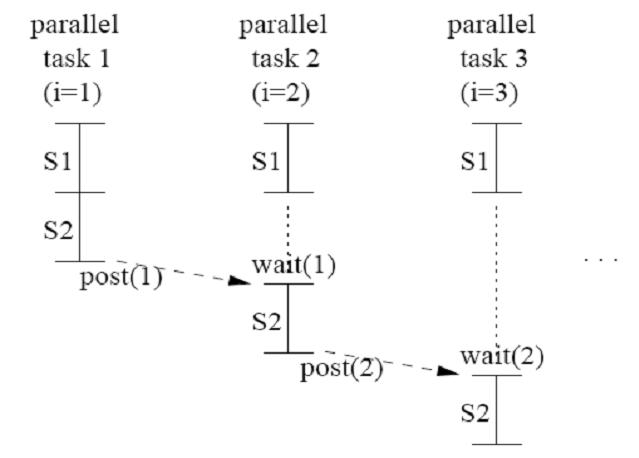CSC/ECE 506 Spring 2010/ch 3 yl: Difference between revisions
| Line 17: | Line 17: | ||
To give a better understanding, we illustrate the dependences using the code section below: | To give a better understanding, we illustrate the dependences using the code section below: | ||
'''for''' (i=1; i<N; i++) | '''for''' (i=1; i<N; i++) | ||
'''S1:''' a[i] = i; | |||
'''S2:''' b[i] = a[i]; | |||
'''S3:''' b[i] = a[i]+c[i]; | |||
'''S4:''' z[i] = 2*i; | |||
====Loop-independent==== | ====Loop-independent==== | ||
Revision as of 20:51, 20 February 2010
Supplement to Chapter 3: Support for parallel-programming models. Discuss how DOACROSS, DOPIPE, DOALL, etc. are implemented in packages such as Posix threads, Intel Thread Building Blocks, OpenMP 2.0 and 3.0.
Parallel-programming models
Loop-independent vs. loop-carried dependences
Before performing the three kinds of parallelism analysis, we need to discuss about loop-dependence analysis first.
Statement dependences
To discuss code analysis, let's define the framework as follows. Let S denote a statement in the source code. Let [] denote loop iteration space. Let S1 -> S2 denote statement S1 executes before S2. Then, we further define three statement dependences:
- S1 ->T S2 denotes true dependence: S1 -> S2, and S1 writes to a location that is read by S2.
- S1 ->A S2 denotes anti dependence: S1 -> S2, and S1 reads a location written by S2.
- S1 ->O S2 denotes output dependence: S1 -> S2, and S1 writes to the same location written by S2.
To give a better understanding, we illustrate the dependences using the code section below:
for (i=1; i<N; i++)
S1: a[i] = i;
S2: b[i] = a[i];
S3: b[i] = a[i]+c[i];
S4: z[i] = 2*i;
Loop-independent
Loop-carried dependences
DOALL
for i:=2:N-1 do A(i):=[A(i-1) + A(i) + A(i+1)]/3; next i; forall i:=2:N-1 do A(i):=[A(i-1) + A(i) + A(i+1)]/3;
for (i=2; i<=n; i+=2) s: a[i] = a[i-2]; for (i=3; i<=n; i+=2) s: a[i] = a[i-2];
DOACROSS
In code 3.7, apparently there is a loop-carried dependence existing in the code.
S[i] -> T S[i+1]
Obviously, there is no way to implement it as DOALL parallelism.
Code 3.7 A loop with loop-carried dependence
for (i=1; i<=N; i++) {
S: a[i] = a[i-1] + b[i] * c[i];}
If we split code 3.7 as two loops, then the fist loop can be implement in DOALL parallism. In code 3.8, first of all, we create a new array named temp[i]. Second, we put temp[i] in a loop which is individual and loop-independence. However, this solution generated a disadvantage: high storage. Due to increasing the array size of temp by i++, the size of temp depends on the number of iterations instead of threads. If N ( # of iteration) is bigger, then the size of temp will be larger.
Code 3.8 A split version of the loop in Code 3.7
for (i=1; i<=N; i++) { //this loop has DOALL parallelism
S1: temp[i] = b[i] * c[i];}
for (i=1; i<=N; i++) {
S2: a[i] = a[i-1] + temp[i];}
Let's see code 3.9, We still create a new array temp[i]. There are two differences between code 3.9 (DOACROSS) and code 3.8 (DOALL). First, the size of array is not increasing by the # of iterations but the # of threads. Second, there is only one loop which contains S1 and S2. In DOACROSS parallelism, we insert two primitives, wait(name) and post(name).
Code 3.9 Exploiting DOACROSS parallelism in the loop from code 3.7
post(0);
for (i=1; i<=N; i++) {
S1: temp[i] = b[i] * c[i];}
wait(i-1);
S2: a[i] = a[i-1] + temp[i];
post(i);}
